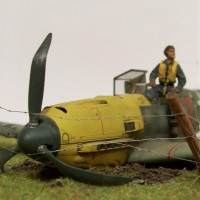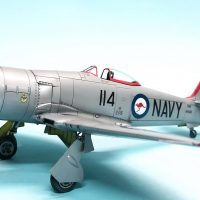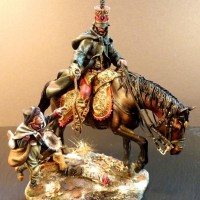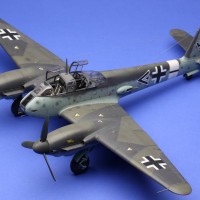An early B-17: before the Flying Fortress became a legend!
Does a B-17 Flying Fortress really need to be presented in modelling circles? Probably not, if it is a representative of the thousands of E, F or G versions built, but very well, if one is faced with the early variant B-17B as in this case! To substantiate this assertion, a brief superficial examination suffices: is it not the case that the searching eye finds much that is familiar here, but is left puzzled in some places?
The B-17B and the early versions of the "Flying Fortress"
In my opinion, the unusually small rudder is the first thing that catches the eye. Below it, the familiar tail section with its angular glazing is missing; glass can be found here, but in the form of a glass tail cone. If you look further forward along the hull, you stumble across strange but beautifully shaped bumps that are reminiscent of the observation and defence stands of a PBY Catalin and should actually fulfil a very similar purpose. It is remarkable that the B-17B has three of them: a third pod is somewhat more concealed on the belly of the bomber.
Further deviations from the familiar appearance of a B-17 can also be found in the forward areas: although the elongated superstructure at the rear of the fuselage of this early Flying Fortress already accommodated the two pilots as well as the navigator and radio operator, it did not yet feature a defence post in the form of a turret, but instead two aerodynamically favourable glass superstructures. In general, the number, size and position of the windows on the fuselage and around the cockpit of the B-17B differ significantly from the subsequent versions. The glazed nose shows the characteristic proportions and the flat glass surface in the centre, which was intended to provide the bombardier with an undistorted view.
The wings, undercarriage and tailplane, on the other hand, have the familiar dimensions and proportions. Only on the engine cowling does the attentive eye notice that the multi-part radiator flap rings are missing. These will only be seen from the D version onwards, as the four Wright R-1820 engines are still enclosed by a one-piece cowling.
The 39 B-17Bs produced in total were the first "Flying Fortress" to be built in series, and delivery of the first aircraft to the USAAC began in October 1939. The outbreak of war in Europe had accelerated the development of the long-range bomber, which had been undergoing trials since 1935, and also prompted the start of series production. However, these aircraft were still being trialled and used to gather operational experience, and it was not until the subsequent B-17C was presented in July 1940 that the potent design became a truly operational bomber capable of surviving in a fierce conflict.
With the installation of self-sealing tanks, effective armouring and reinforced armament, the experience gained during the first year of the war was taken into account. 42 B-17Cs were used by the USAAC, and a further 20 of these aircraft went to the RAF as Fortress Mk.Is. Another year later, in July 1941, the B-17C was replaced by the B-17E, which now had the three weapon stations at the top behind the cockpit, the ball turret under the fuselage and the tail gunner's station.
Another characteristic innovation was introduced in the E version: from now on, instead of the narrow fin known as the "shark tail" of previous versions, the bomber's appearance was to be characterised by an enlarged tail fin that was extended far forward. This measure to improve directional stability had been adopted from its civilian sister, the Boeing Model 307 Stratoliner. The B-17 Flying Fortress had thus grown into its familiar appearance - six months before the USA entered the war.
Kit and building process
The well-known Academy kit No. 2106 "B-17B Flying Fortress" was used for the realisation of this model. In 1991, this kit variant was derived from moulds first produced in 1988. This age is evident in the layout and the quality of the parts. The construction can be accomplished in a few steps and with a minimal amount of parts from today's perspective.
This can be seen as an invitation, if not an advantage (I'm inclined to think so), because the level of detail required can be determined and controlled in this way! You don't always want to spend a lot of time and energy adding details to the inside of the fuselage that will soon disappear into the dark as the building process progresses.
With this in mind, I bought Eduard etched part sets for the undercarriage bays, the engines and the cockpit/front section, which were largely installed. The interior of the fuselage, on the other hand, remained in its empty basic state. The cockpit, which is quite easy to see into, was given seat upholstery from Kits-World, which looks quite good with its characteristic yellow colour. Fortunately, matching resin wheels were available for the B version; the rather poorly designed original parts would have been a shortcoming here.
A real drawback was the quality of the kit decals: these proved to be unruly and brittle and were difficult to use and could only be used with a lot of touching up. This was particularly evident with the blue, white and red version of the tail fin: the decals provided for this were such "self-destructors" that I ended up painting this part myself - which doesn't always have to be a disadvantage! In my opinion, the unruly nature of the decals is mainly due to their age - to be fair!
Building an early Flying Fortress has given me some interesting new insights into the prototype and has also reminded me in a more general sense that the obsession with detail in a kit does not always automatically increase the pleasure of modelling: I will gladly reach for one of the tried and tested Academy kits of a B-17 Flying Fortress again!
































Excellent model and great work on a rare prototype. You did well with the decals and the early Fortress really shines.
Well done. Like the many varied shaded panels.
Very well done. Early Forts are the best looking.
Such a gorgeous build of a beautiful aircraft! Well done, and thanks for posting.
Top notch work all around- build, interiort, paint, photography, everything. One of the top posts of the summer so far. Congrats!
Beautiful, the first iteration of the B-17 was a very sleek ship and your model shows it well.
A real beauty and also unique.
Amazing early Fort.
Excellent job and awesome result on this rare version, Roland!
Excellent article, too!
Awesome build! I love the early Forts.
That’s a beautiful model, Roland. I remember when that kit came out and I immediately built one. I currently have a C/D in the stash waiting for attention.
This is an impressive build of the early B17, Roland @rosachsenhofer
On some of those pictures it looks like a real one.
That's very nice work on this. A great result - I particularly like the multi-hue NMF.
Very nice build
A truly remarkable and very important build!
What a lovely build! Well done.
Fantastic model, Roland @rosachsenhofer! 👏 She is beautiful in every respect! 🤩
Let me thank you all very much for your motivating and interested comments! I am very pleased that the elegant and slender shapes of this early "Flying Fortress" not only appeal to me, but also meet with your approval. Thank you all for your appreciated words and mentions!
I agree with the previous comments and add that the article was well written and entertaining to read.
Beautifully built model & excellent article too!
Excellent job on your build. This early B-17 looks great!
Thank you, Robert, Jay and Bob, for the positive feedback - not least with regard to the text, that makes me even happier!
Very nice to see a build of an early Fortress. Excellent build (and debrief on the process as well) - Cheers
Thank you very much for this kind reply!
Excellent and superb Roland (@rosachsenhofer).
I am a big fan of the early B-17. That shark fin is so unique. The kit is a fairly easy build, I have one in my display case as well (B-17D). I've been considering if I might repaint it since it has been in excess of 20 years since it was done and I think I might do better now.
But it would not compare to this beauty you've just presented.
Amazing job on the Academy kit, Roland @rosachsenhofer! I agree that the early '17's are quite striking. Really wish someone would produce a good modern kit of one of these early variants. Even the prototype or YB-17. I doubt they would sell well, however. Really enjoyed looking at your photos.